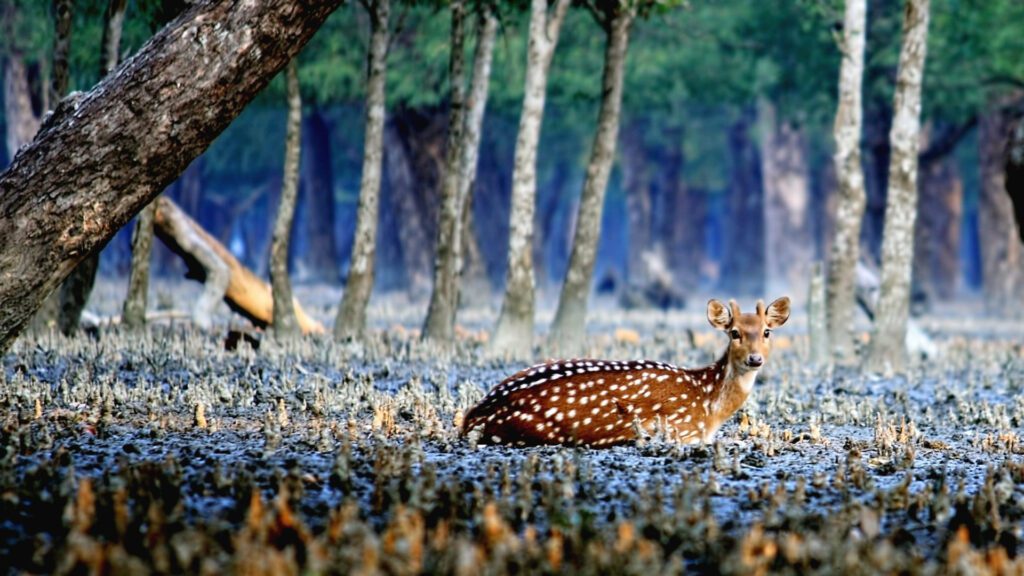Wild Life

- Spotted Deer: The Sundarbans is home to a significant population of spotted deer, also known as chital. These beautiful deer can be seen grazing in the forest clearings and are an important prey species for tigers and other predators.
- Rhesus Macaques: Rhesus macaques, a species of Old World monkeys, are commonly found in the Sundarbans. They are agile and can be observed jumping from tree to tree, foraging for food in the mangrove forests.
- Birds: The Sundarbans is a paradise for bird enthusiasts, with a wide variety of avian species. Keep an eye out for kingfishers, herons, egrets, storks, ibises, and various species of birds of prey. The region is also known for being a wintering ground for migratory birds.
- Reptiles: Besides crocodiles, the Sundarbans is home to other reptiles such as monitor lizards, snakes (including venomous species like the King Cobra and Russell’s Viper), and turtles. These reptiles play a vital role in the ecosystem.
- Marine Life: The Sundarbans is a unique ecosystem where freshwater meets the saline waters of the Bay of Bengal. It supports a diverse range of marine life, including dolphins, crustaceans, and various species of fish.
- It’s important to note that wildlife sightings are never guaranteed in the wild, and the dense mangrove forests can make it challenging to spot certain animals. However, exploring the Sundarbans with the guidance of experienced local guides and through boat safaris increases your chances of encountering these remarkable creatures in their natural habitat.
- Remember to maintain a safe distance, respect the wildlife, and adhere to the guidelines set by the forest department to ensure the well-being of the animals and your own safety.
- Mangrove Forests: The Sundarbans is famous for its dense mangrove forests, which cover a significant portion of the region. These mangroves are adapted to the saline water and tidal conditions, and their intertwined roots provide stability to the land. Take a virtual tour to witness the mesmerizing sight of tall, sturdy mangrove trees growing from the muddy soil.
- Biodiversity: The Sundarbans is home to a diverse range of flora and fauna. It is renowned for its population of Bengal tigers, which are excellent swimmers and thrive in the mangrove habitat. Other wildlife species include estuarine crocodiles, spotted deer, wild boars, macaques, and various species of birds, including the beautiful white-bellied sea eagle. Explore the virtual world of the Sundarbans to catch glimpses of these incredible creatures.
- Sajnekhali Wildlife Sanctuary: In the heart of the Sundarbans, you’ll find the Sajnekhali Wildlife Sanctuary. It is a popular spot for visitors and researchers. Take a virtual visit to the sanctuary, where you can explore a museum showcasing the region’s flora and fauna, and climb a watchtower to observe the wildlife in their natural habitat.
- Bird Watching: The Sundarbans is a haven for bird enthusiasts. It is home to a wide variety of avian species, including kingfishers, herons, egrets, ibises, and many more. Virtual bird-watching tours can give you a glimpse of these beautiful creatures as they soar above the water or perch on the branches of the mangroves.
- Sundarbans National Park: The Sundarbans National Park, a UNESCO World Heritage Site, is located within the Sundarbans region. It encompasses a significant part of the Sundarbans and is a critical area for conservation. Take a virtual journey through this protected area to appreciate its ecological significance and the efforts made to preserve it.
- Local Communities and Culture: The Sundarbans is not only about its natural beauty but also about the local communities that have lived here for generations. The residents have a unique lifestyle closely connected to the forest. Learn about their culture, traditions, and reliance on the Sundarbans through virtual cultural showcases or documentaries.
- Remember, while virtual exploration can provide a glimpse into the Sundarbans, experiencing it in person offers an entirely different level of immersion. If you plan to visit the Sundarbans, make sure to gather the necessary information, permits, and engage local guides to ensure a safe
- The Sundarbans is renowned for its rich and diverse wildlife. Here’s a glimpse into the fascinating wildlife you may encounter when exploring the Sundarbans:
- Bengal Tiger: The Sundarbans is home to the majestic Bengal tiger, one of the most iconic and elusive big cats in the world. These tigers are excellent swimmers and have adapted to the unique mangrove habitat. Spotting a Bengal tiger in the wild is a rare and thrilling experience.
- Estuarine Crocodile: The Sundarbans is also known for its population of estuarine crocodiles, which are well-adapted to brackish water environments. These formidable reptiles can be observed sunbathing on riverbanks or lurking in the water, waiting for their prey.
- Fishing Cats: Fishing cats, with their webbed feet and keen hunting skills, are found in the Sundarbans. These medium-sized wildcats are excellent swimmers and are known for their ability to catch fish, giving them their name.
- and enriching experience.
